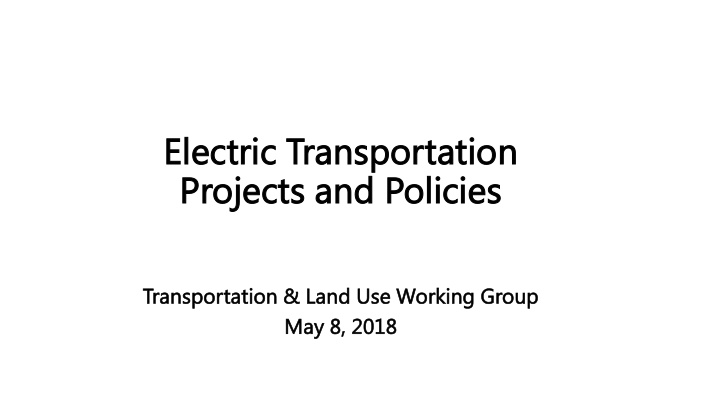



Elec ectri ric T Tra ransportation Pr Projec ects a and Policies es Transp sportation & Land U Use W Worki king G Group May ay 8, 8, 2018 2018
Goals • Keep doing what we’re doing • Emissions reductions • Reduce vehicles miles traveled • Increase vehicle electrification • Cost effectiveness • Reach under-served communities
“Over their lifetime, battery electric vehicles produce far less global warming pollution than their gasoline counterparts” (Union of Concerned Scientists) • Electricity Sources and Emissions - 2017 • ≈50% less CO2 • Source: U.S. DOE Alternative Fuels Data Center
What’s Working • EV sales are up in California, Colorado, Hawaii, Oregon, Vermont, and Washington • Here’s why: • Wide variety of models • State and Local Incentives - fee exemptions, parking, HOV lanes, tax credits • More charging stations • Workplace charging • Special Promotions
Dane County
Projects, Programs and Policies – EVs • Goal: 50% of car sales electric by 2040. • Improve affordability/adoptability through incentives ($1,000 to $5,000 per vehicle). • Increase access to affordable electric vehicle transportation options for low-income populations. • Prioritize electrification of buses and shared use vehicles to reduce the need for personal vehicle use/ownership. • Add X% county fleet vehicles to electric and encourage cities, towns and villages to do the same. • Replace at least X number of gas or diesel powered vehicles with EVs.
Projects, Programs and Policies – Infrastructure • Upgrade residential infrastructure accordingly. • Near- term: 15 DCFC stations and 150 Level 2 stations. • Increase charging infrastructure at single family and multifamily developments by X%. • Develop EV parking hubs. • Prioritize electrification of shared use vehicles, bikes and buses to reduce the need for personal vehicle ownership
Projects, Programs and Policies – Other • EV- ready provisions for affordable housing. • EV-ready construction requirements for multifamily developments. • EV-ready construction provisions for commercial and residential dwellings. • Municipal and city policies to support curbside charging. • Bulk purchasing opportunities that could bring down the cost of charging. • Policies that make it easier to provide publicly accessible charging on private property. • Mileage- based road user fees. • New road pricing mechanisms to stabilize revenues and manage vehicle travel demand.
Outreach and Education • Educate key stakeholders on EVs • Municipalities • Businesses • Residents • Developers • Educate dealership sales staff on EVs • Encourage dealerships to have EV inventory • Understand charging • Know their inventory and benefits
Outreach and Education • Incentives/programs to encourage dealerships to promote Evs. • Ride and drives at community events, local businesses. • Social media campaigns. • Utility communications – newsletters, bill inserts, web content. • Possible EV education center. • Smart road funding.
Discussion
Recommend
More recommend